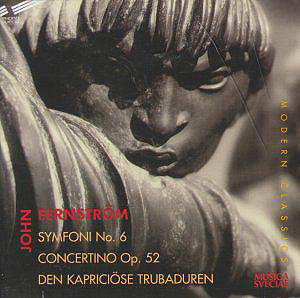Fernström
was born in China and was brought up there by his missionary parents
until the age of nine when he and an elder brother was sent to
Sweden for their further schooling. It was in Sweden that his
interest in music was first kindled. In 1913 he attended Malmö
Music Conservatory. He moved to Stockholm and after a rift with
his parents eventually became a violinist with the Helsingborg
Symphony Orchestra. Dreams of becoming a great violinist came
to naught. In 1923 he began serious study of composition with
Peder Gram. By 1931 he had written three symphonies. He played
violin in restaurants in the evening and summer months and conducted
a choir and gave music lectures.
The
Sixth Symphony is from 1938, the same year that he unsuccessfully
applied to be appointed director of the Helsingborg Orchestra.
Passed over he left Helsingborg and went to live in Malmö.
Gradually fame and attention came his way with many works played
in concert and on radio.
Lund
became his home from 1943 to 1961. There he wrote symphonies 8
to 12, the opera Achnaton and the Second Violin Concerto.
From the early 1950s his prodigious talent for music began to
shrivel. As head of a music school with heavy administrative duties
his creative side was allowed to fall away.
The
Sixth Symphony is a big structure lasting more than 47
minutes. It is in four movements. The first is reflective of Nielsen's
dynamic and stomping power - also to be heard in slightly different
livery in Rosenberg in his third and sixth symphonies. The second
movement speaks peacefully from a sleepy hollow. The chipper third
movement is strong with upstart woodwind chirruping and hiccuping
along and thunderous drum punctuation. The finale seems to be
a phantasm of an early Sibelian symphonic tempest with the blurt
and rasp of the First Symphony prominent and references back to
the chipper third movement giving a degree of cohesion. I am not
at all sure that this coheres as well as the tauter Lan Shui version
on Bis but the recording really is excellent. Towards the end
of the finale, and casting off the deadening feeling of fugal
working out, we can hear the eager brightness of works like Wirén's
Serenade and Larsson's Pastoral Suite. The piece
ends in a blaze of thunder like a modern shade of the apotheosis
of the dance from Beethoven's Seventh Symphony.
The
Concertino was described by Rangström as ‘a
butterfly at twilight with gold dust on its wings’. So he wrote
after a Stockholm performance in spring 1943. Fernström and
his brother-in-law (Gustaf Paulson) were captivated by the poetry
of the American Carl Sandburg. The Concertino is for flute, small
orchestra and women's choir and the words set a poem ‘New Moon’
by Sandburg. This exalts the fanciful poetry of a twilight buzzing
with fireflies and moonlit Red Indian images, unsaddled ponies,
night-rides and silver foxes gazing at the moon. His intention
was to capture the vague melancholy fantasy of the poem.
The
Capricious Troubadour was written during autumn 1930 at
about the same time as the Fourth Symphony and the Symphonic Variations.
Fernström had just returned from a year's study at Sondershausen
in Germany and planned to put the lessons learnt there into practice.
Accordingly we hear in this four movement (Preludium, cantabile,
giocoso, finale) suite many Sibelian touches alongside gestures
linking with Mahler and Weill. The parallels with Sibelian theatrical
suites are clear enough with a super-fine Bergian dusting but
a robust galloping open-air feeling in the Finale. The dominance
goes to the same light and playful divertissement mood-set as
Larsson and certain works by Von Koch.
The
three works here are very naturally recorded with, if this is
not a conflict in terms, the woodwind favoured. Franck seems less
at home with the symphony but is completely at home with the fine
skein of the Concertino. Solyom, who has shown himself an adept
conductor in other Musica Sveciae releases, is superb in The
Capricious Troubadour serenade.
This,
like all the Musica Sveciae series, is superbly documented. I
could only have wished that they could have found a work other
than one already recorded by Bis to replace the Mikko Franck version
of the symphony.
Rob
Barnett
